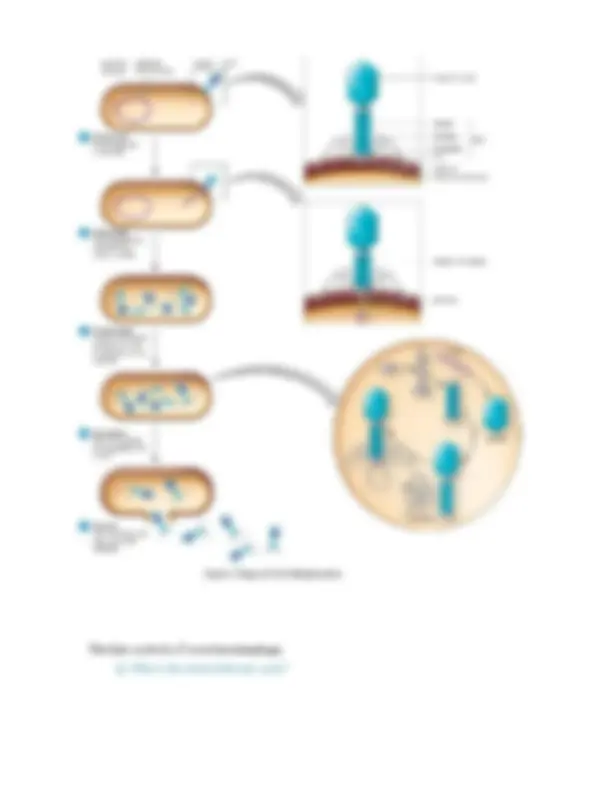








Study with the several resources on Docsity

Earn points by helping other students or get them with a premium plan


Prepare for your exams
Study with the several resources on Docsity

Earn points to download
Earn points by helping other students or get them with a premium plan
Community
Ask the community for help and clear up your study doubts
Discover the best universities in your country according to Docsity users
Free resources
Download our free guides on studying techniques, anxiety management strategies, and thesis advice from Docsity tutors
theory of Biogenesis essay/quiz
Typology: Essays (university)
1 / 10

This page cannot be seen from the preview
Don't miss anything!







The nucleic acid in a virion contains only a few of the genes needed for the synthesis of new viruses. These include genes for the virion's structural components, such as the capsid proteins, and some of the enzymes used in the viral life cycle. Enzymes needed for protein synthesis, ribosomes, tRNA, and energy production are supplied by the host cell and are used for synthesizing viral proteins, including viral enzymes. Thus, for a virus to multiply, it must invade a host cell and take over the host's metabolic machinery. A single virion can give rise to several or even thousands of similar viruses in a single host cell. In a few viral infections, cells survive and continue to produce viruses indefinitely. The multiplication of viruses can be demonstrated with a one-step growth curve. The data are obtained by infecting every cell in a culture and then testing the culture medium and cells for virions and viral proteins and nucleic acids. Multiplication of Bacteriophages The basic mechanism of viral multiplication is similar for all viruses. Bacteriophages can multiply by two alternative mechanisms: the lytic cycle or the lysogenic cycle.
Q : What can be found in the cell during biosynthesis and maturation? ATTACHMENT 1. After a chance collision between phage particles and bacteria, attachment, or adsorption, occurs. During this process, an attachment site on the virus attaches to a complementary receptor site on the bacterial cell. This attachment is a chemical interaction in which weak bonds are formed between the attachment and receptor sites. T-even bacteriophages use fibers at the end of the tail as attachment sites. The complementary receptor sites are on the bacterial cell wall. PENETRATION 2. After attachment The T-even bacteriophage injects its DNA (nucleic acid) into the bacterium, the bacteriophage's tail releases an enzyme, phage lysozyme, which breaks down a portion of the bacterial cell wall. During the process of penetration, the tail sheath of the phage contracts, and the tail core is driven through the cell wall. When the tip of the core reaches the plasma membrane, the DNA from the bacteriophage's head passes through the tail core, through the plasma membrane, and enters the bacterial cell. Therefore, the phage particle functions like a hypodermic syringe to inject its DNA into the bacterial cell. Figure 1 A viral one-step growth curve. No new infective virions are found in a culture until after biosynthesis and maturation have taken place. Most infected cells die as a result of infection; consequently, new virions will not be produced
The lytic cycle of a T-even bacteriophage. Q: What is the result of the lytic cycle? Figure 2 Stage of Viral Multiplication
Q: How does lysogeny differ from cycle? Bacteriophage Lambda (λ): The Lysogenic Cycle In contrast to T-even bacteriophages, some viruses do not cause lysis and death of the host cell when they multiply. These lysogenic phages (also called temperate phages) may indeed proceed through a lytic cycle, but they are also capable of incorporating their DNA into the host cell's DNA to begin a lysogenic cycle. In lysogeny, the phage remains latent (inactive). The participating bacterial host cells are known as lysogenic cells. We will use the bacteriophage λ (lambda), a well-studied lysogenic phage, as example of the lysogenic cycle.
Certain animal viruses can undergo processes very similar to lysogeny. Animal viruses that can remain latent in cells for long periods without multiplying or causing disease may become inserted into a host chromosome or remain separate from host DNA in a repressed state (as some lysogenic phages). Cancer causing viruses may also be latent. Specialized transduction. When a prophage is excised from its host chromosome, it can take with it a bit of the adjacent DNA from the bacterial chromosome.
Bacteriophages vs Animal Viruses